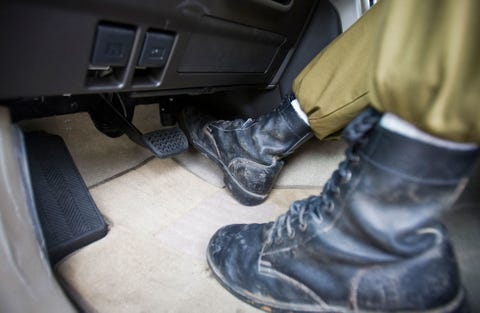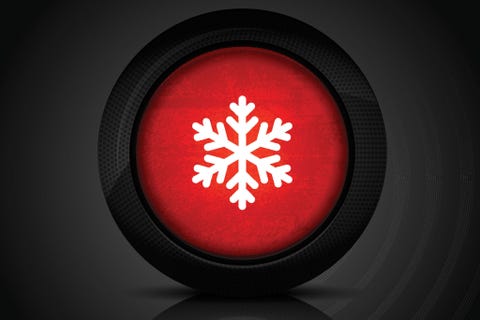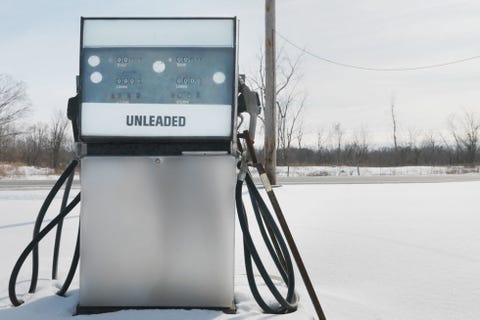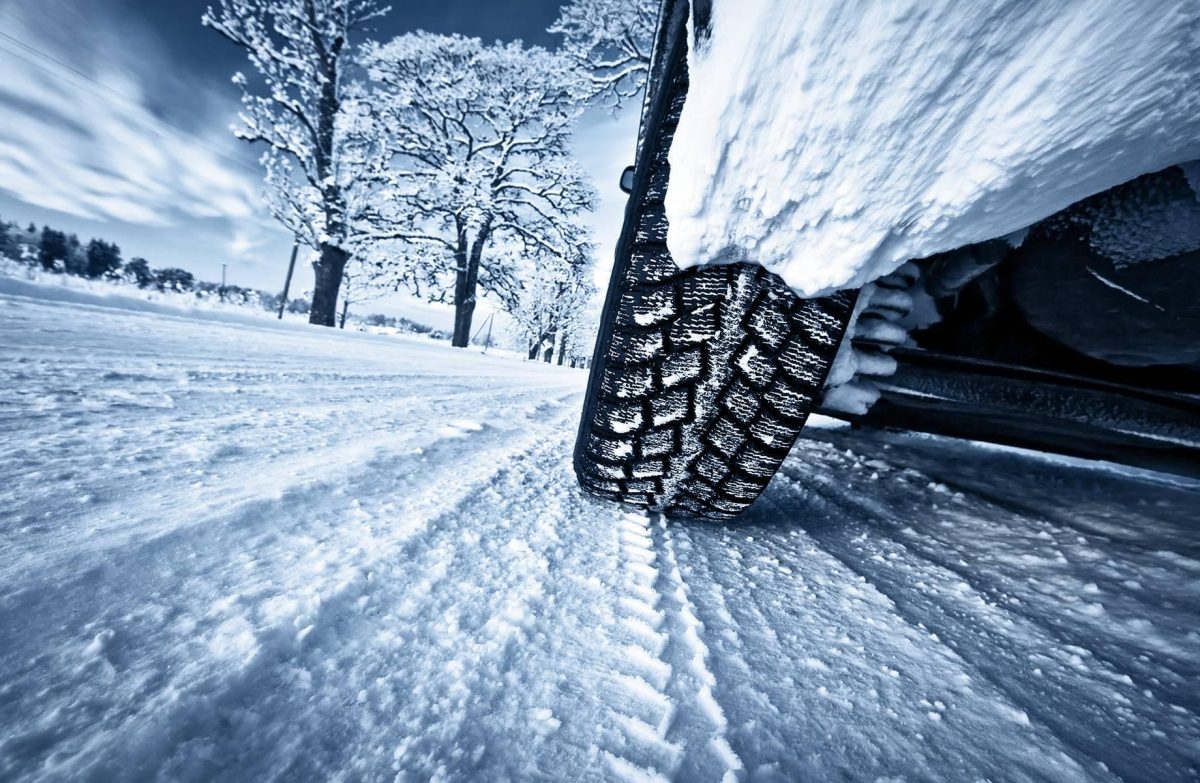Ice and snow can certainly make travel in the wintertime a treacherous experience. So it’s important to be armed with helpful information to get you safely through the snow season. We decided to gather advice from the professional drivers from three very different disciplines. From the racing world, we spoke with world record holder, stunt driver and star of Top Gear USA Tanner Foust. Alex Debogorski, fan favorite of the TV show Ice Road Truckers, lent us his wisdom from more than 40 years of over-the-road winter hauling. And to get a perspective from someone who tunes the chassis’ of Chrysler’s most potent machines, we spoke with Erich Heuschele, manager of SRT vehicle dynamics and 20-year ice racing veteran. Here’s what they had to say about winter driving.
1. Be Aware of Your Surroundings and Read the Terrain

“There are clues, dead giveaways that tell you where the most icy and dangerous spots are on the road,” says Foust. Correctly reading the terrain is key to avoiding a skid or worse—an accident. So our experts agree it’s crucial to study the road surface and choose a path that avoids potentially hazardous spots. Foust says, “If you drive into the shadow of a mountain, or even a stand of tall trees, recognize that there could be some ice or slippery condition hiding in the shade.” So it’s important to slow down when you see these clues, even if the rest of the road is bone dry. SRT’s Heuschele says he recently noticed an icy condition on his drive home that was causing accidents and completely avoidable. He says, “It was very cold, about 10 degrees, and the tracks everyone was driving in had turned to glare ice.” He continues, “All you had to do was move the car over two feet to the right or left and you had great traction. But nobody was doing it.” Sometimes the smartest route isn’t the one the rest of the motorists are taking. Debogorski says the most dangerous conditions can be right around freezing. “Maybe there’s still ice on the ground but it’s melting,” he says. “When the sun comes out and makes the ice wet, you’re in trouble unless you have very good tires.”
2. Separate the Controls

“I spent 8 years at the Bridgestone winter driving school and I credit that early snow experience as a secret to my on-track success in the first half of my career,” says Foust. “The things that you learn driving on ice and snow translate to virtually every driving environment.” Foust says a car has just three main jobs: it accelerates, it corners and it brakes. And in order to maximize the performance of each function, you generally need to do them one at a time. First, brake in a straight line. And in a turn, stay off both pedals and wait until you begin to straighten the wheel before you feed in any throttle again. That’s because combining too many of these functions on a slippery surface will use up all the available traction. He says, “Having the discipline to separate controls allows people to really maximize the performance of the car, even if it’s the very limited performance available on ice.” Debogorski adds that in winter conditions drivers should never try to change the car’s direction in a hurry. “Every time you do something too quickly, you put yourself in a position to lose control,” he explains.
3. Pack Emergency Winter Clothes to Stay Warm

The long list of helpful products and supplies you could bring along with you when travelling in remote, snowy climes would include items like an emergency kit, tow strap, and even an air compressor. But the most crucial item, the one that topped the list of all three of our advisors, included some form of extra warm clothing. And that’s because your survival could depend upon simply staying warm if stranded in freezing weather. Debogorski suggests carrying long underwear along. It’s a solution that maximizes protection against the cold and minimizes the space required to bring it. He says, “A lot of people see us on the show and they say, ‘Hey you’re jumping out of your truck and you don’t seem to be dressed very well.’ Well, I’ve got some pretty good underwear on and some really good socks on, too.” Debogorski also packs (and wears) two winter balaclavas. “The good ones bunch up around your neck and will go right down your coat. And they have a drawstring that shrinks the size of the opening around your face.” Heuschele always carries a winter coat in the back seat of his car during the winter, as well as gloves, boots and a blanket in the trunk.
4. Don’t Fight Stability Traction Control Systems

We know that a vehicle’s electronic stability control system (ESC) uses a steering angle sensor, a yaw sensor and a lateral G sensor in addition to the ABS wheel speed sensors. The system takes the information from these sensors and decides how and when it should intervene. “Stability control is a path maintenance system,” says Heuschele. “It tries to maintain the path it thinks the driver wants to take.” So he encourages drivers to be more mindful with the vehicle controls. If the vehicle starts to slide, he cautions, don’t immediately counter steer in the opposite direction at full steering lock. Extreme and abrupt maneuvers like that will make the system think you want to turn the vehicle in the opposite direction. The result? It will take ESC longer to make the right corrections. He says the best course of action is to tone down your steering wheel inputs and straighten the wheel. The intervention from the system will be much more subtle. And the same goes for traction control. Be smooth with the throttle application. “If you fight the system, if you plant your right foot on the floor, it’s going to shut you down really hard.” And that means it will take longer to make forward progress.
5. Use The Right Mode

Many new cars, trucks and SUVs have a “snow” mode. In the old days, these modes simply meant that the transmission started in third gear to limit wheelspin. But now, engineers include specific “snow” or low-grip tuning for the throttle mapping, all-wheel drive system, traction control system, ABS system, stability control system and more. So Heuschele suggests owners of vehicles with “snow” modes in their transmissions or all-wheel-drive systems to always use them. “We change the tuning based on these modes. By selecting ‘snow,’ you’re giving the vehicle a little heads-up primer as to what’s going on.” He adds, “So for instance, on the Grand Cherokee SRT8, we run more torque to the front wheels in ‘snow’ mode. So now it doesn’t have the time delay of seeing slip to the rear wheels and then having to send more up front to try and balance things out.” Using the vehicle’s “snow” mode simply makes the driving experience more seamless because the systems know you are on a low-grip surface and can likely figure out a correction more quickly.
6. Where and When to Chain Up

Many states don’t require passenger vehicles to use chains for winter driving. And generally, our experts agree that winter tires outperform chains on most surfaces. But in some states, where the majority of the residents live in a dry hot climate, you might need to carry chains into the mountains—even if you have mud and snow rated truck tires or even proper winter tires. “Most people wait until the last possible minute to chain up,” says Debogorski. “I get it, they’re inconvenient. But if you see people stuck or spinning their tires, put on your chains.” He admits that even he was resistant to putting them on in his younger days. He says, “They’d tell us to chain up and I wouldn’t. I made it up the mountain because the guys using the chains would chew up the snow and give me the traction, not because I was the better driver.” He advises winter drivers to use a designated safe area, like an official vehicle chain-up area to install your chains. But be sure to practice putting them on in your driveway once or twice—so the process will be smooth and easy in the field. Foust cautions against cheap chains that don’t cover the whole tread in an “X” or “Z” pattern. “If the chains are the type that only go across the tread linearly, they have a tendency to skate sideways across the road,” says Foust. “I’ve seen cars literally track on ice sideways at a near dead stop because they were skating on the chains.”
7. Top Off Your Tank

We all do it. Drivers of all experience levels often avoid refueling until the fuel gauge reaches “E” or the low fuel light glows. And in densely populated areas with fuel stations every few miles, that’s just fine. But in the mountains during the winter months, stretching a tank of fuel is not a risk worth taking. A bad accident can snarl traffic for hours in a remote and treacherous section of road. “I’ve been stuck on Highway 70 for 11 hours before,” says Foust. “So you want to make sure you’re not pushing empty when you’re about to head into the mountains.” Heuschele suggests always refueling a vehicle when it gets to half a tank. He says, “You can idle a car all night on a half a tank of gas and keep yourself warm—and almost a whole day on a full tank.”
8. Don’t Postpone Vehicle Maintenance

“If the car is in borderline mechanical condition, it’s always going to give you trouble at the temperature extremes,” says Heuschele. A battery, for example, could be cranking well all summer and then start to slow as the cold weather sets in. So, Heuschele suggests, don’t wait until it dies—just put a new one in. And Debogorski agrees, “If you have an old battery and it’s fifteen below, your car may not start.” And all three of our advisors suggest keeping windows clean. “I usually replace my wiper blades every year, and it’s right before winter,” says Heuschele. Additionally, some of our advisors like using products such as Rainex on their windows and windshield because it helps keep the snow and road grime from building up. Many drivers will forget to clean and remove snow from their headlights and taillights. But cleaning these lamps are more important now than ever. “LED headlights and taillights don’t generate the heat of old-school lights,” Heuschele says. “So if you’re driving a car with LEDs, you must stop periodically and get out and clean them.”
Colin Dilley, VP of Technology at Prestone, recommends you check your cooling system before driving in cold weather. Inspect your antifreeze/coolant to make sure it is free of debris and contaminants. If you notice an issue, flush and fill your system with a mixture of 50% concentrated antifreeze and 50% distilled water. If your reservoir is low, top off with with a product like Prestone 50/50 Prediluted Antifreeze/Coolant. Next, using a Prestone antifreeze tester, you can check the concentration and ratio of your antifreeze.
From Popular Mechanics









